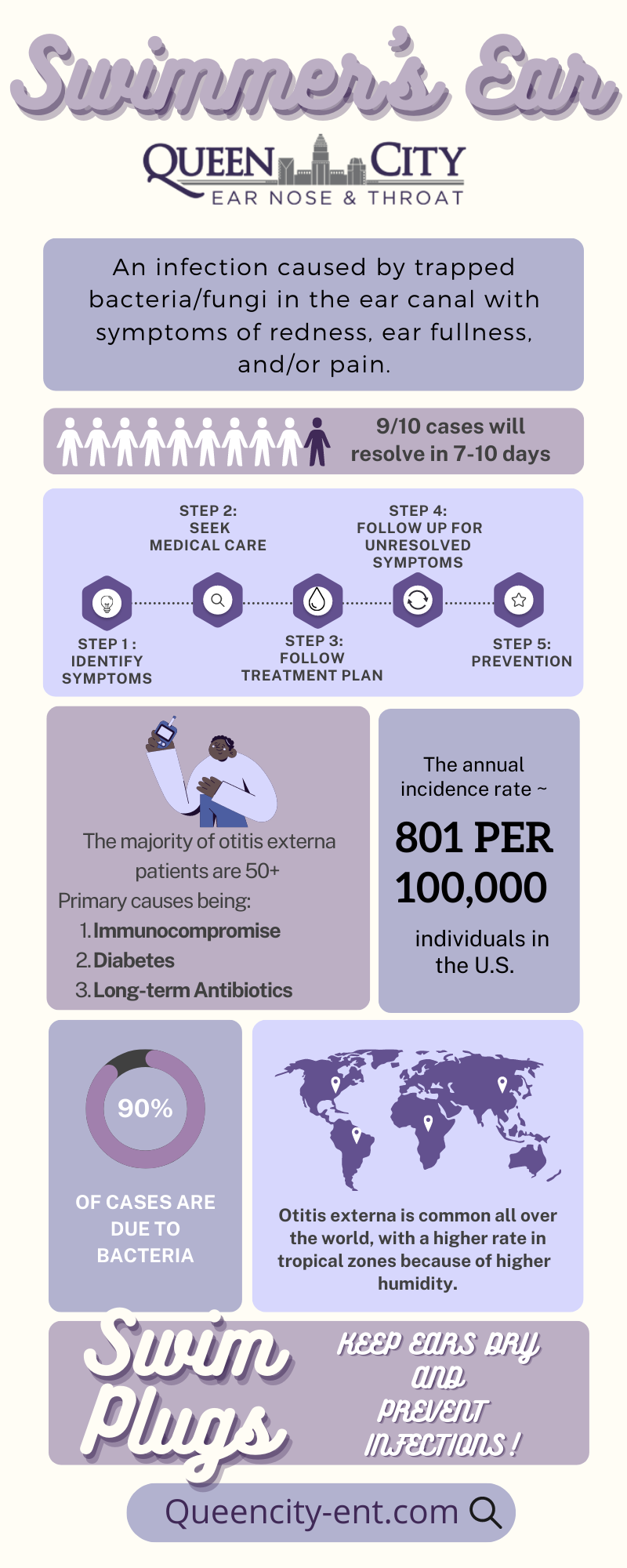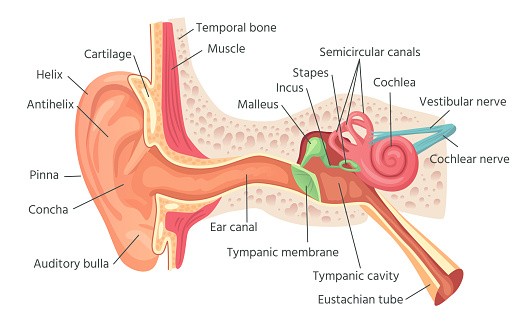Swimmer's Ear & Swim Plug Solutions
Every summer our Audiologists and ENTs manage one of the most common ear infections referred to as Swimmer's Ear (Also called Otitis Externa). Otitis Externa is a bacterial infection usually caused by water that stays in the outer ear canal for an extended period of time, providing a moist environment for bacteria to grow. Anyone can get swimmer's ear, but it is most often seen in children.
Signs & Symptoms
- Pain when the outer ear is tugged or when pressure is applied
- Itchiness inside the ear
- Drainage from the ear
- Redness and swelling in the ear
- Tinnitus (ringing/buzzing)
Some Statistics on Otitis Externa
What can cause Otitis Externa?
| Systemic Diseases | Skin Diseases | Environmental Factors |
Trauma
|
Anatomical Factors
|
Endogenous Factors
|
Other Factors
|
Depending on the suspected cause of your hearing loss, our ENTs may refer you for further testing and evaluation.
by Author
Diagnosis
If you have experienced these symptoms, and treatment from your primary care / emergency doctor is not effective they may refer you to an Otolaryngologist (ENT) and/or Audiologist to evaluate your symptoms.
Your doctor will likely diagnose swimmer's ear based on symptoms you report, questions he or she asks, and an office examination. You probably won't need a lab test at your first visit. Your doctor's initial evaluation will usually include:
- Examining your ear canal with a lighted instrument (otoscope). Your ear canal might appear red, swollen and scaly. There might be skin flakes or other debris in the ear canal.
- Looking at your eardrum (tympanic membrane) to be sure it isn't torn or damaged. If the view of your eardrum is blocked, your doctor will clear your ear canal with a small suction device or an instrument with a tiny loop or scoop on the end.
Further testing
Depending on the initial assessment and symptom severity, your doctor might recommend additional evaluation, including sending a sample of fluid/debris from your ear to a lab to identify the presence of bacteria or fungus.
If your eardrum is damaged or torn, our ear, nose and throat specialists (ENT) will examine the condition of your middle ear to determine if that's the primary site of infection. This examination is important because some treatments intended for an infection in the outer ear canal aren't appropriate for treating the middle ear (space behind your eardrum).
If your infection doesn't respond to treatment, your doctor might take a sample of discharge or debris from your ear at a later appointment and send it to a lab to identify the microorganism causing your infection.
Treatment
The goal of treatment is to stop the infection and allow your ear canal to heal.
Cleaning (No QTip swabs - performed by Your Doctor Only!)Cleaning your outer ear canal is necessary to help eardrops flow to all infected areas. Your doctor will use a suction device or ear curette to clean away discharge, clumps of earwax, flaky skin and other debris.
Medications for infectionFor most cases of swimmer's ear, your doctor will prescribe eardrops that have some combination of the following ingredients, depending on the type and seriousness of your infection:
- Acidic solution to help restore your ear's normal antibacterial environment
- Steroid to reduce inflammation
- Antibiotic to fight bacteria
- Antifungal medication to fight infection caused by a fungus
If your ear canal is completely blocked by swelling, inflammation or excess discharge, your doctor might insert a wick made of cotton or gauze to promote drainage and help draw medication into your ear canal. If your infection is more advanced or doesn't respond to treatment with eardrops, your doctor might prescribe oral antibiotics.
Ask your doctor about the best method for taking your eardrops. Some ideas that may help you use eardrops include the following:
- Reduce the discomfort of cool drops by holding the bottle in your hand for a few minutes to bring the temperature of the drops closer to body temperature.
- Lie on your side with your infected ear up for a few minutes to help medication travel through the full length of your ear canal.
- If possible, have someone help you put the drops in your ear.
- To put drops in a child's or adult's ear, pull the ear up and back.
Medications for pain
Your doctor might recommend easing the discomfort of swimmer's ear with over-the-counter pain relievers, such as ibuprofen (Advil, Motrin IB, others), naproxen sodium (Aleve) or acetaminophen (Tylenol, others). If your pain is severe or your swimmer's ear is more advanced, your doctor might prescribe a stronger medication for pain relief.
Prevention
Once Swimmer's ear is treated (especially if this has been a recurring problem) it is important to find preventative measures that work for you so this doesn't happen again!
1.Keep ears as dry as possible.
- Use a bathing cap, ear plugs, or custom-fitted swim molds when swimming.
Our Audiologists offer services for custom swim earplugs made for you and your ears to keep them as dry as possible!
2. Dry ears thoroughly after swimming or showering.
- Use a towel to dry ears well.
- Tilt head back and forth so that each ear faces down to allow water to escape the ear canal.
- Pull earlobe in different directions when ear faces down to help water drain out.
- If there is still water in the ear, consider using a hair dryer ON A LOW HEAT SETTING to move air within the ear canal.
3. Check with your healthcare provider about using ear-drying drops after swimming.
- DON'T use these drops if you have ear tubes, punctured ear drums, swimmer's ear, or ear drainage.
- DON'T put objects in ear canal (including cotton-tip swabs, pencils, paperclips, or keys).
- DON'T try to remove ear wax. Ear wax helps protect the ear canal from infection. (If you think the ear canal could be blocked by ear wax, check with your ENT!)
Preparing for Your Appointment
Here are some suggestions to help you get ready for your appointment.
Make a list of:
- Your symptoms and when they started
- All medications, vitamins and supplements you take, including doses
- Your allergies, such as skin reactions or drug allergies
- Questions to ask your doctor
Some basic questions to ask your doctor about swimmer's ear include:
- What is likely causing problems with my ear?
- What is the best treatment?
- When should I expect improvement?
- Do I need to make a follow-up appointment?
- If I have swimmer's ear, how can I keep from getting it again?
- Do you have brochures or other printed material I can have? What websites do you recommend?
Your doctor is likely to ask you questions, including:
- Have you been swimming lately?
- Do you swim often?
- Where do you swim?
- Have you ever had swimmer's ear before?
- Do you use cotton swabs or other objects to clean your ears?
- Do you use earbuds or other ear devices?
- Have you had any other recent ear examinations or procedures?
The First Step
Don't spend your summer in the doctor's office with recurring ear infections (no matter the severity). Our offices are readily available to provide an evaluation, consultation, and treatment recommendation best suited for you. Our Audiologists and Otolaryngologists at Queen City Ear, Nose, & Throat pride ourselves in providing all of our patients with a personalized, informed, research based approach to their needs. The first step is reaching out!
Call our offices at (704) 703-1080 or book an appointment online today!
References:
- https://www.aafp.org/afp/2001/0301/p927.html
- https://www.nhsinform.scot/illnesses-and-conditions/ears-nose-and-throat/otitis-externa
- https://www.mayoclinic.org/diseases-conditions/swimmers-ear/symptoms-causes/syc-20351682
- https://my.clevelandclinic.org/health/diseases/8381-swimmers-ear-otitis-externa
- https://www.hopkinsmedicine.org/health/conditions-and-diseases/otitis-externa
- https://www.ncbi.nlm.nih.gov/books/NBK556055/





